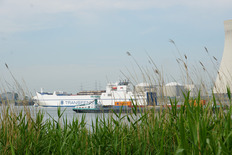- Engineering studies for Antwerp@C's CO2 infrastructure are funded by a Connecting Europe Facility grant and Flemish government subsidies.
- A final investment decision for the first phase is expected in late 2022.
- The project aims to reduce CO2 emissions at the Port of Antwerp by 50% by 2030.
- The infrastructure includes a central backbone, CO2 liquefaction unit, and maritime loading facilities.

Project Overview
Antwerp@C aims to reduce CO2 emissions by 50% at the Port of Antwerp by 2030 through a shared CO2 infrastructure. This initiative involves leading chemical and energy companies and the Port of Antwerp.
Engineering Studies
Following a feasibility study in 2021, the project has moved to the engineering phase. This phase includes the construction of a central backbone throughout the port, a CO2 liquefaction unit, interim storage, and maritime loading facilities. The studies are partially funded by a Connecting Europe Facility grant, Flemish government subsidies, and contributions from consortium participants. A final investment decision for the first phase is expected in late 2022.
Open Season Initiative
Fluxys, Air Liquide, and Pipelink have organized an 'Open Season' to gauge initial demand for the proposed CO2 infrastructure. Companies in the wider port area were invited to express their interest in CO2 transmission and terminalling infrastructure. The market response will inform the final investment decision.
Port of Antwerp's Role
The Port of Antwerp hosts Europe's largest integrated energy and chemicals cluster, making it an ideal location for innovative CO2 reduction projects. The Antwerp@C consortium, formed in 2019, aims to build a CO2 infrastructure to support future Carbon Capture Utilization & Storage (CCUS) applications. This project could become one of the world's largest multimodal open-access CO2 export facilities.

